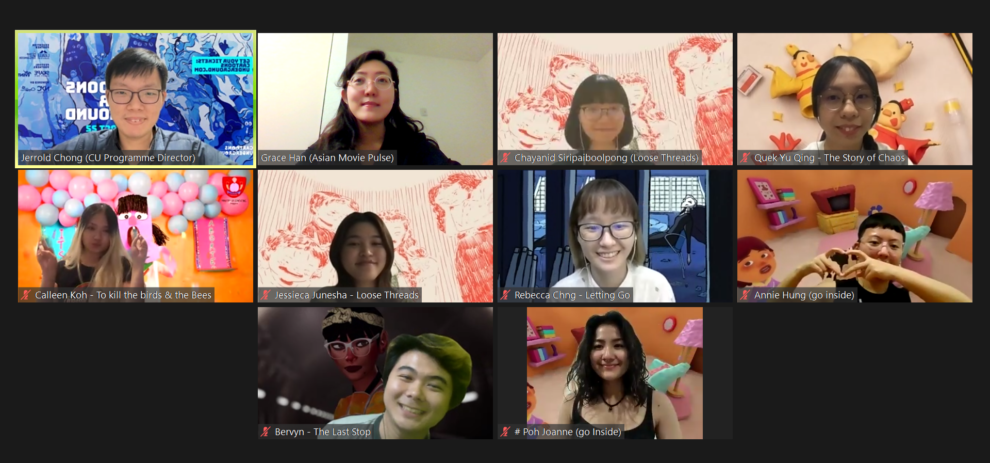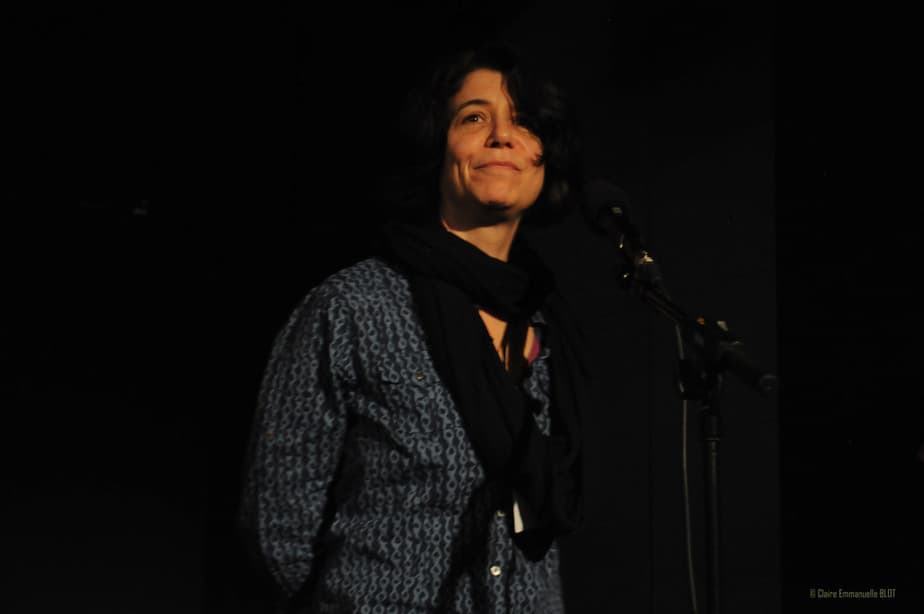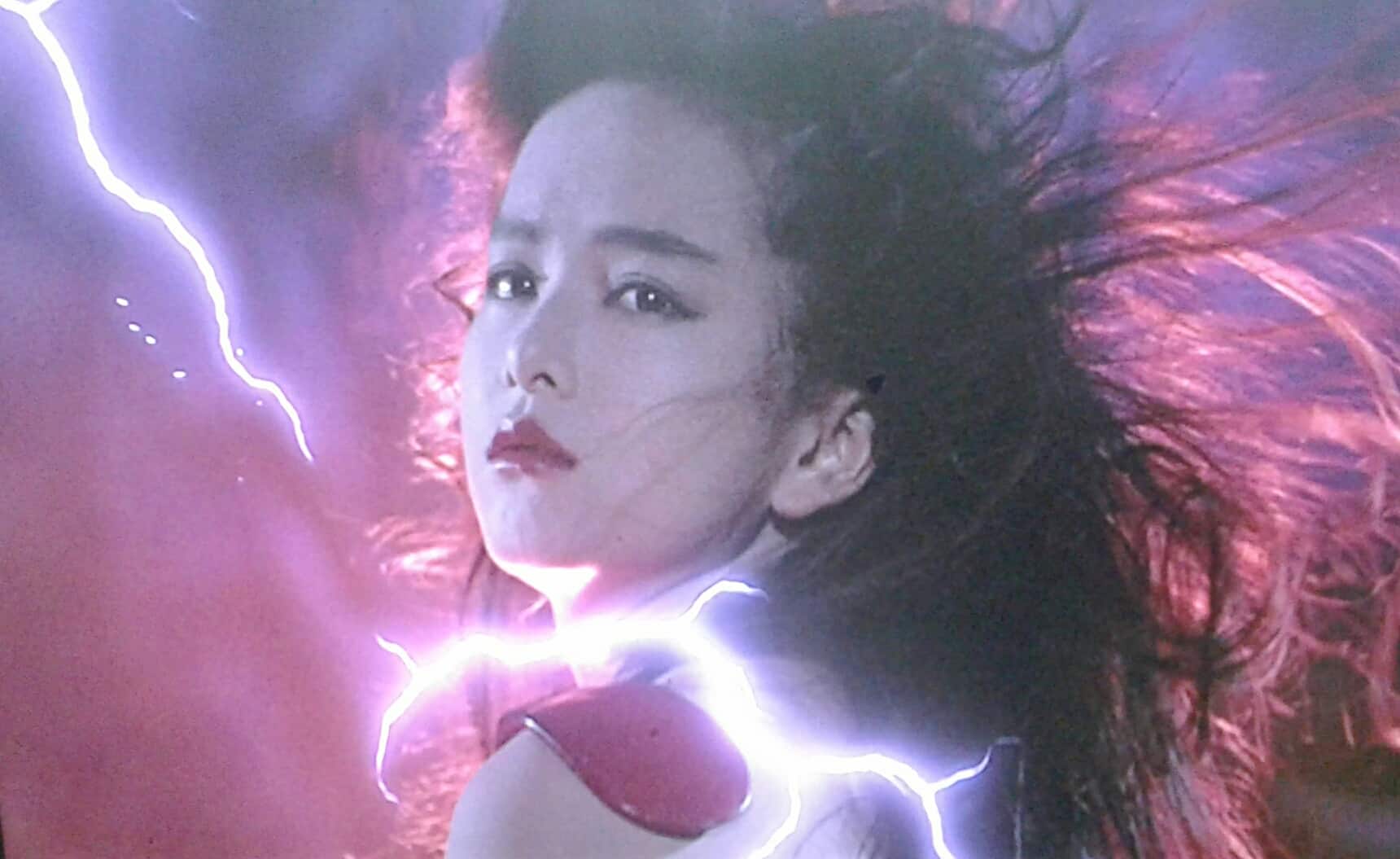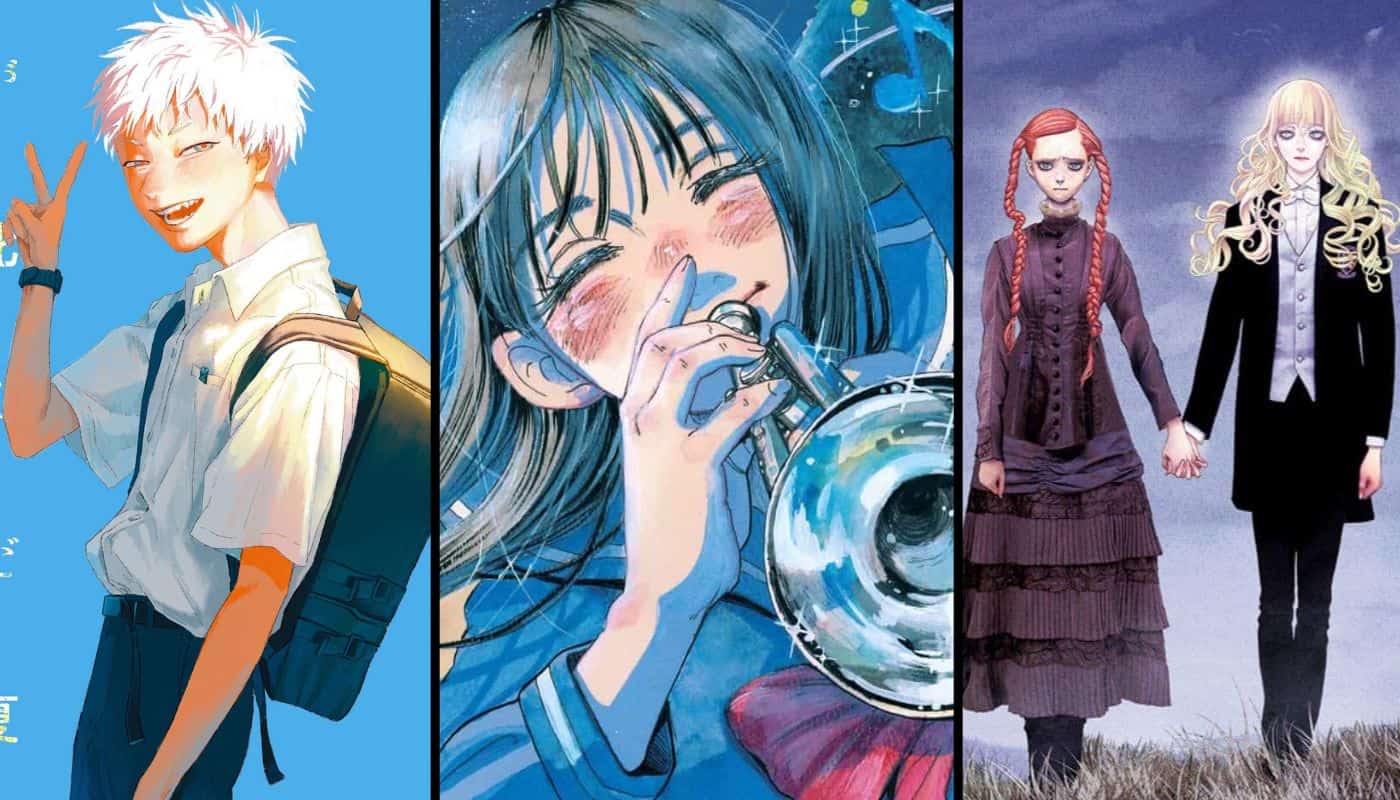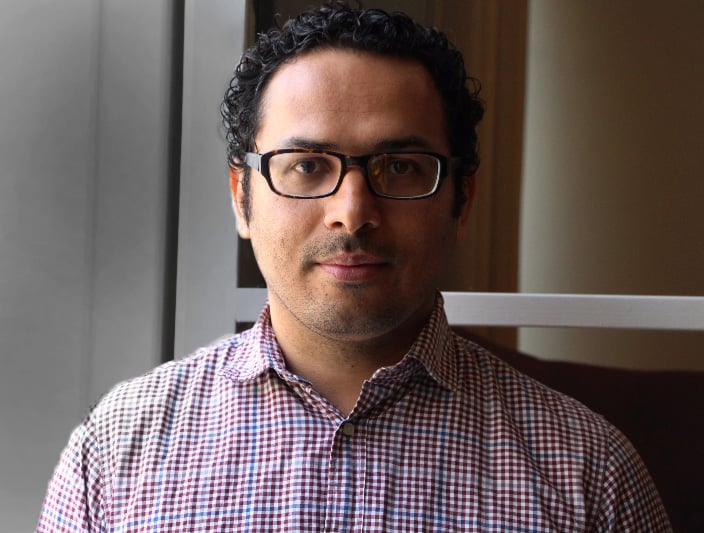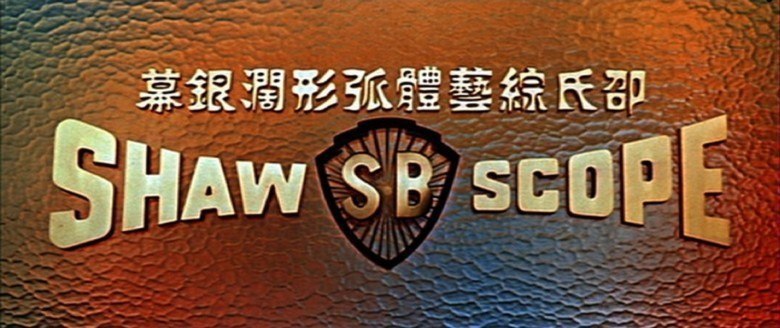Since 2020, we hosted a roundtable dedicated to the voices of the Singapore Student Competition – meeting students and fresh grads from LASALLE College of the Arts, Nanyang Technological University, and Nanyang Academy of Fine Arts.
Now, even though the 11th edition Cartoons Underground is going fully in-person this year, we've been fortunate enough to have a conversation with this year's batch of fresh-faced animators once again. To start, we have returnee Calleen Koh, who made a splash two years ago with her hilarious (and strangely erotic) short, “Sexy Sushi.” This year, she returns to Cartoons Underground with a newer, longer short, “To Kill the Birds and the Bees,” which similarly revolves around the theme of sexual taboo – though this time in the confines of a hyper-sexual, yet hyper-prudish, society. Rebecca Chng animates a teen going through a different struggle, where he learns to process the memories of his late sister in “Letting Go.” Quek Yu Qing takes the school theme further in “The Story of Chaos,” which involves a Chinese legend as told by an easily-distracted student in stop-motion. Chayanid Siribaipoolpong and Jessica Junesha, on the other hand, joined the call together to think aloud the familial intimacies by a grandmother losing her memory in “Loose Threads.” Annie Hung and Joanne Poh also showed up as the team for “go inside,” where play-doh-like aesthetics dominate a CGI clip of someone accidentally eating their lover. Finally, Bervyn Chua takes CGI the other end, directing a heartstopping 1-minute short of a lone commuter trapped in a train in “Last Stop.”
The sheer variety of mediums this year has been impressive, to say the least. We're delighted to present to you six of the seven competing teams from this year below.
This interview has been redacted and edited for clarity.
How did you get into animation?
Chayanid Siripaiboolpong (“Loose Threads”): I got into animation because it's a combination of the things to do: developing and sharing stories, drawing and exploring designs.
Jessica Junesha (“Loose Threads”): I've always known I've wanted to get into the arts. Animation for me is a boundless medium, where you can do whatever you want to do with it.
Rebecca Chng (“Letting Go”): I never thought of getting into animation until university. I realized animation is about movement, which played into things I've loved in the past – like dancing and anime.
Bervyn Chua (“Last Stop”): I went to a lot of open houses [before declaring a major]. I thought of business and law as my first choice. When I went to the animation department of Nanyang Polytechnic last, however, I fell in love.
Quek Yu Qing (“The Story of Chaos”): This may be cliche, but I got interested in animation after being seriously inspired by Miyazaki films like “Howl's Moving Castle” and “Ponyo.” More than that, I think I generally had a strong interest in stories and reading books. So it was natural to pursue [animation].
Calleen Koh (“To Kill the Birds and the Bees”): I actually answered this question two years ago! [laughs] I think for me, films provide a safe space for me. It's a place where I could feel happy and scared and sad either in front of my computer or in the theater. There's something comforting about a medium we grew up watching one way or another.
What are some inspirations for your film, then?
Annie Hung (“Go Inside”): For [“Go Inside”], we wanted to talk about relationships and infatuation; intimacy and vulnerability. I really struggle with making things look organic and more similar to my 2D art style in 3D. So I tried to make everything look very lumpy in [“Go Inside”]. I guess that also fits into the theme of the body, the inside organs. I also took a lot of inspiration from Abracadaniel in “Adventure Time” for the purple character.
Joanne Poh (“Go Inside”): I think the most prominent [motif] is the bao – a Chinese pastry – and then turning it into a book.
Bervyn Chua: [According to our assignment,] we had to make a 1-minute film in 2 months. [“Last Stop”] is really inspired by “Inception,” “Interstellar,” and “Dunkirk,” where there's a lot of tension. I also really love adult animation like “Love, Death and Robots,” and non-animated film like Denis Villeneuve's “Blade Runner” and “Sicario.” Our lead artist took a lot of inspiration from Alberto Mielgo, who worked on “Love, Death, and Robots” and “Spiderman: Into the Spider-verse.”
Quek Yu Qing: [“The Story of Chaos”] shows the combination of interests, because [the film] is actually an adaptation of an ancient Chinese legend. The film was also inspired by Gianluca Maruotti's claymation music video, “Free to Roam.” I think that the clean animating style and flat layers are influenced by him.
Chayanid Siribaipoolpong: I am inspired by Sophie in “Howl's Moving Castle” and the grandmother in “My Neighbor Totoro.” So there's some Studio Ghibli in there. We were also inspired by Jeon Jinkyu's “The House of Loss,” which played at Cartoons Underground this year.
Calleen Koh: We were inspired by puppet shows like “The Muppets” and “Don't Hug Me, I'm Scared,” and “Sesame Street.”
You all have an incredible handle of the mediums you work with. Could you tell more more about your character designs? How did you decide your art style?
Quek Yu Qing: Initially, I tried to make [my film] all on paper. Bu what looks nice in my iPad can look terrible in real life. So I had to get used to 3D material, form, and shapes. Since my film is also an ancient Taoist story, I also went back and did a lot historical research on Chinese motifs and clothing design. I tried to translate this aesthetic research straight into my consciousness.
Rebecca Chng: For me, I try to draw on paper first and think of interesting designs. I try interesting shapes. For my film, I began with the sister first. I wanted her to feel big and bright. After that, I worked on the main character. It was a lot of trial and error. I like trying something new every time.
Chayanid Siripaiboolpong: [“Loose Threads”] was inspired by my own grandmother who has Alzheimer's. We asked our parents to send us their old photos of our grandmothers; we looked at contemporary outfits and hairstyles.
Bervyn Chua: We looked around at the other [university] students for inspiration. We tried [to design] students from business and science, and then finally ended up with an art school girl. We wanted to make something that was edgy, very teenage, very grunge.
Calleen Koh: We wanted to portray the different dimensions of Singaporean life. We also wanted to retain this childish style to contrast with the darker themes of the film through the crayon-like textures and phallically-shaped characters. No matter how much we try to hide it, sex will always be a part of our life.
Annie Hung: We took quite a while to design the characters. We wanted them to visibly contrast each other. Since our purple character is uptight, his head is big – like his brain is going to explode or something. The other one is more laid back and chill, so he looks more casual. We also wanted the characters to look gender neutral. People always ask us, “Is this a guy or a girl?” And we answer, “We don't know. They're just people – Person A and B.”
Calleen and Bervyn – could you tell us some more about your music design?
Calleen Koh: For the introduction, we wanted to introduce the audience to this [filmic] world with jazzy morning tunes to give the audience a very nice, clean view of Singapore. The twins arc is more like MTV/Ariana Grande and recent pop music. The sex ed song is actually based on real life though – they made us learn it in school. It kind of went like this: [sings] “A is for Abstinence and B is Being Faithful and C is Condoms~” [laughs]
Since the film is so full of music, we wanted to make the ending intentionally silent. We want to impress the message that these conversations about sex are just non-existent.
Bervyn Chua: There are a lot of scenes in” Dunkirk” where Christopher Nolan inserts a “shepherd's tone” – a tone that starts from a deeper pitch and than increases very slowly at a loop. It gives a sense of discomfort. I put that into the whole film to create the tension. We also wanted to add some familiar sounds from the MRT [the Singaporean metro line]. Only 30% were from the Singaporean MRT, however; the remaining 70% were from [trains] from all around the world, like from Hong Kong and Japan's Shinkansen. We looked to foley for the rest of our sounds – like for passing lights, birds fluttering by, speeding car sounds inside the train – to create this sense of impossible speed within the MRT.
I think this segues well into another aspect of sound design: voice-acting. In “Story of Chaos,” the act of storytelling is put into question; in “Loose Threads,” the voiceover invokes the intimacy of familial memory; and in “Letting Go,” there are so many voice actors involved. How did you all go about finding your voice actors, and figure out what to say when?
Quek Yu Qing: The student's narration is constantly interrupted by the teacher, so I integrated the voiceover with typography to help the viewer differentiate each disruption. The composer also came up with the idea to use the music. In the [student's] story, there's a constant melody. Out of the story, there is not much music accompanying the film – mostly sound effects and foley.
It was actually very hard for me to find voice actors, since I wanted my student [character] to be a child actor. This wasn't very easy, especially during the pandemic. In the end, I acted out the voice by myself and then I modified the voice in audio program. For the teacher, I managed to ask a friend who does a lot of Chinese drama.
Chayanid Siribaipoolpong: The voice actor is actually my aunt. She sent me the recordings through LINE. We would go back and forth, and I would request her to re-record again and again.
We originally also wanted the script to be a long monologue describing each memory one at a time, which we switched to a more stream-of-consciousness approach. We also had the script in English, which we later translated to Thai.
Rebecca Chng: The voice acting was the hardest part of my film. For the main character, I have a friend who's an actress who knows an actor. He had to do quite a few rounds, so I treated him to Starbucks after that. [laughs] I wanted to have a proper voice actor [for my main], because there's the awkward laughing. It's hard to pull off, unless someone is trained.
Bervyn and “Go Inside” crew, I thought it was interesting to see how you two both experimented beyond the smooth Pixar-esque CGI that we see in mainstream animation. Could you say more about how you did what you did?
Annie Hung: 3D can look too smooth, too shiny. I really wanted to break away from that. So we added a lot of texture and lumpiness. I was also looking at Raman Djafari's work. We also wanted to replicate a bit of plasticine stop motion. [As a result,] we posterized the frames to make [the frame rate] choppy, which also saved us time on the animation.
Joanne Poh: Coloring the environment was a big issue for us. We had to go through a few iterations of that – to show the mood of the room, the characters, the spaces they are in.
Annie Hung: Moreover, when we were making the film, a lot of the 3D environments are slanted, or the walls are pointed in weird directions. This is because we warped the geometry itself, not just the camera.
Bervyn Chua: Since we only have one minute of screen time, I wanted our film to be loud sonically and visually. We used a lot of bright lights – like when the stations pass by – so that the audience won't be able to sleep anymore. We also used textures, like graffiti on the trains. We also made our character's makeup dark and her hair messy on purpose. We also used MS Paint, drawing with a mouse. We would also experiment in 3-frame segments: one inverted, one normal, and one inverted again.
I think it is really exciting to see new styles emerge. In this vein, what do you guys want to do in the future? What are your next steps?
Callen Koh: I've been working with Finding Pictures after graduating last year, where I've been making TV series. I also just finished a short film last week, called “Buns.” It will project on 29 December. After that I will go on vacation and then think about what to next.
Quek Yu Qing: I also graduated last year, and have been working as a freelance animator/illustrator. I would want to try a different theme for a story next time. At the moment, I'm focusing on taking it slow, absorbing different influences and reading different stories.
Jessica Junesha: At the moment, [Chayanid and I are] working together on our graduation film. Since I'm from Indonesia, I've been observing the animation industry from here. I think there's a lot of animation potential there. Hopefully I'll be able to work back home.
Chayanid Siribaipoolpong: I don't have a concrete plan yet, but I'd like to work as a concept artist or visual development. I'm still deciding whether I want to go back to my country [Thailand] or stay here in Singapore.
Rebecca Chng: I graduated last year and I've been working full time as an illustrator-animator. I'm trying to take things one step at a time and experience life. I adopt ideas in my head – there are some small projects I'm thinking of, but I think they'll take time. I want to be in the animation industry for a long time, so I want to take things slow and steady.
Bervyn Chua: The five guys who worked on this film are now doing their own thing; my teacher calls it the “Beatles splitting up.” The technical artist and I are doing another Unreal Engine CG short film about a museum thief fighting a museum guide for an artifact. It will also come out next year.
Annie Hung: Joanne and I are in our final year, and we are working on our final year projects separately. I am trying to make a film about queer love in Singapore. I've been interviewing a lot of people for the past month to get people to talk about their queer love, and I think we'll be doing this for the next few months. It has been very wholesome so far.
Joanna Poh: My short film will be more of an action car thriller, in a dystopian Singapore. There will be an island full of dogs and wolves. It will be a mixture of 2D and 3D. We want to see how we can push the boundaries of 3D especially!
That's great. I look forward to seeing all of your work in future editions of Cartoons Underground!


